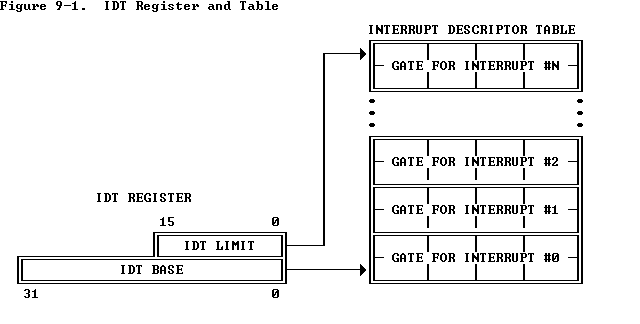up:
Chapter 9 -- Exceptions and Interrupts
prev: 9.3 Priority Among Simultaneous Interrupts and Exceptions
next: 9.5 IDT Descriptors
9.4 Interrupt Descriptor Table
The interrupt descriptor table (IDT) associates each interrupt or exception
identifier with a descriptor for the instructions that service the
associated event. Like the GDT and LDTs, the IDT is an array of 8-byte
descriptors. Unlike the GDT and LDTs, the first entry of the IDT may contain
a descriptor. To form an index into the IDT, the processor multiplies the
interrupt or exception identifier by eight. Because there are only 256
identifiers, the IDT need not contain more than 256 descriptors. It can
contain fewer than 256 entries; entries are required only for interrupt
identifiers that are actually used.
The IDT may reside anywhere in physical memory. As
Figure 9-1
shows, the
processor locates the IDT by means of the IDT register (IDTR). The
instructions
LIDT and
SIDT operate on the IDTR. Both instructions have one
explicit operand: the address in memory of a 6-byte area.
Figure 9-2
shows
the format of this area.
LIDT (Load IDT register)
loads the IDT register with the linear base
address and limit values contained in the memory operand. This instruction
can be executed only when the CPL is zero. It is normally used by the
initialization logic of an operating system when creating an IDT. An
operating system may also use it to change from one IDT to another.
SIDT (Store IDT register)
copies the base and limit value stored in IDTR
to a memory location. This instruction can be executed at any privilege
level.
Table 9-2. Priority Among Simultaneous Interrupts and Exceptions
Priority Class of Interrupt or Exception
HIGHEST Faults except debug faults
Trap instructions INTO, INT n, INT 3
Debug traps for this instruction
Debug faults for next instruction
NMI interrupt
LOWEST INTR interrupt


up:
Chapter 9 -- Exceptions and Interrupts
prev: 9.3 Priority Among Simultaneous Interrupts and Exceptions
next: 9.5 IDT Descriptors

